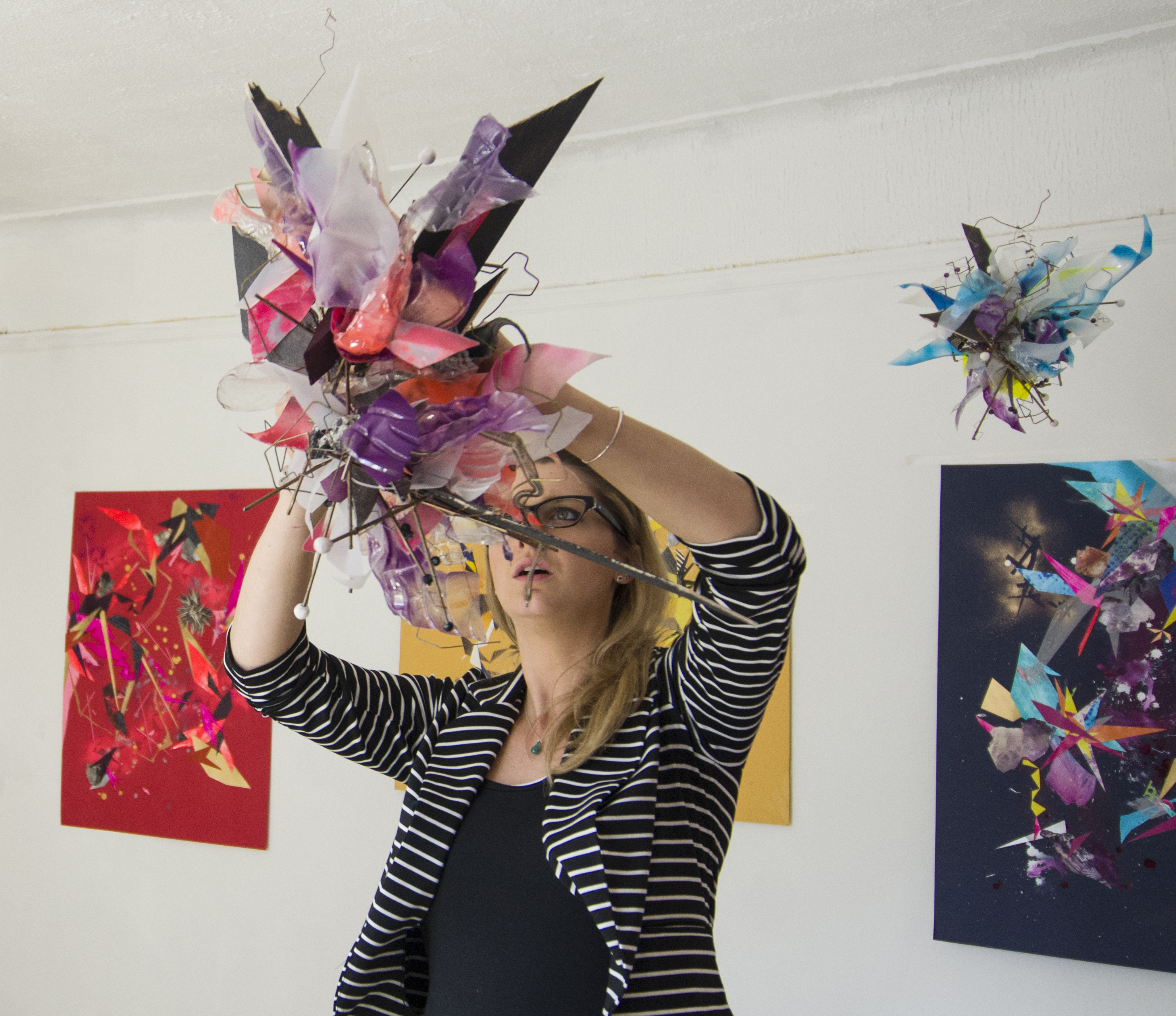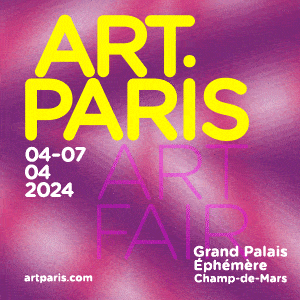Whitehot Magazine
April 2024
"The Best Art In The World"
"The Best Art In The World"
April 2024
Natalie Colette Wood Interview
 Bronx based artist Natalie Colette Wood at work in her studio, November 2014.
Bronx based artist Natalie Colette Wood at work in her studio, November 2014.
By IRENA JUREK, NOV. 2014
Natalie Colette Wood’s paintings and sculptures are a hybrid art form that deconstruct and dissect modes of abstraction, architecture, and fantasy. Wood’s tumultuous hard- edged drips and her use of dazzling materials, such as sequins, rhinestones, and spandex reflect her distinctive vision and memories from a childhood spent in Las Vegas.
Whitehot Magazine arranged the following artist to artist chat between myself and Ms.Wood in her New York studio.
Irena Jurek: You have a complex identity being a first generation American, growing up in a German household. How has this impacted your thoughts and views?
Natalie Colette Wood: Since my mother grew up during the war she always dreamed of living somewhere that was the exact opposite of the darkness that she grew up in Berlin. Obviously Las Vegas was the place for her to be, right? Even though she always wanted to escape the history of her past she always carried that weight with her. Growing up I was always reminded of this dirty reality and I think that looming sense of darkness always comes though my work - that moment that you know everything might erupt and break apart. My paintings are based on real places I have been or imaginary ones. The goal with my work is to convey a fanciful space, the viewer knows it’s not real but wishes it were, like a mirage or an illusion that you could jump into.
 Natalie Colette Wood, Elliptical Star 29” x 31” x 15” Steel, Aluminum, Wood, Glitter, and Glass Beads 2014
Natalie Colette Wood, Elliptical Star 29” x 31” x 15” Steel, Aluminum, Wood, Glitter, and Glass Beads 2014
Jurek: Yes illusion plays an important role in your work but also the play between light and shadow is an essential idea behind your sculptures. That aspect as well as your sculptures being mobiles seems to be a nod to artists from the past such as Alexander Calder.
Wood: Calder has been a big influence for the sculptures, as well as Lee Bontecou's work. What I love about Bontecou and Calder is how they transform the space around them in a way that’s constantly changing depending on the time, installation, and light in the room. I’m creating this ever-changing environment that is constantly in motion and never the same for too long. For example, recently, I have started to create drawings from the shadows my sculptures create.
Jurek: Interesting, I really get the ever changing aspect of your work - absolutely. Also, your use of these discarded materials seems central to the work, and a metaphor emerges from taking these abandoned objects and imbuing them with a sense of significance.
Wood: The materials I work with are a reflection of American culture and of my childhood. I use objects such as water bottles, broken wood, and other found objects typically considered trash and combine them with objects that are hyper feminine such as rhinestones, sequins, glitter, glass beads, hair extensions, and shoes. My grandmother was a seamstress for the shows in Las Vegas and my mother was a dancer in Vegas so I was always surrounded by discarded fabrics and gaudy stage costume material. As a child I remember making my own costumes from leftover materials around the house and just being fascinated by how these objects could transform you into a diva in a matter of seconds.
Jurek: Tranformation in one's process is a complex set of circumstances to deal with. Although your sculptures have this personal, transformative and autobiographical quality, they also seem to be of another world and talking about the sublime. There is this sense of complexity that goes beyond the limits of our own understanding of the world and our place in it.
Wood: The sculptures are created from collected materials from my life and are then fabricated to look like they come from a different planet. They are almost like remnants or futuristic fossils. I’m creating models that are based on my own life but also reference a world that goes beyond the limits of my own experience.
Jurek: There is also something incredibly erotic and sensual about your work, especially in your latest series of paintings. The splotches and squirts of paint are so orgasmic. It’s this sense of pleasure and desire that especially pulls me in.
Wood: Obviously there is a sexual component to the work .There is this tension between being really dirty and super neat at the same time, that creates a push and pull dynamic. This line between chaos and structure relates to ideas of pleasure and pain as well as ecstasy and despair. I’ve also been using bleach, ammonia, and other cleaning materials in combination with paint as a way of accentuating this tension and disrupting the paint.
Jurek: This kind of hedonistic opulence is definitely contrasted with a dark and dystopic vision. Your work then becomes very dramatic, and romantic.
Wood: The work always gets really dark and gnarly, almost like the car crash you can’t look away from after a romantic date. I’ve always had this interest in accidents, natural disasters, and true crime not so much for the gory details but more about how life can change so quickly and dramatically with one decision or act. I want that drama and intensity to come though the work, like the aftermath of an epic event. WM
 Natalie Colette Wood, Elliptical Star 29” x 31” x 15” Steel, Aluminum, Wood, Glitter, and Glass Beads 2014
Natalie Colette Wood, Elliptical Star 29” x 31” x 15” Steel, Aluminum, Wood, Glitter, and Glass Beads 2014
 Natalie Colette Wood, Green Life System, Steel, Plastic, Found Objects, Wood, Silicone, and Glass Beads, 39” x 28” x 21”, 2013
Natalie Colette Wood, Green Life System, Steel, Plastic, Found Objects, Wood, Silicone, and Glass Beads, 39” x 28” x 21”, 2013
 Natalie Colette Wood, Interstellar Love Leftovers, Acrylic, Leather on Canvas, 24” x 24”, 2014
Natalie Colette Wood, Interstellar Love Leftovers, Acrylic, Leather on Canvas, 24” x 24”, 2014

Irena Jurek
Irena Jurek is an artist, writer, and curator based in New York. She has contributed to Art F City, New York Arts Magazine, Whitehot magazine, and others.
view all articles from this author








